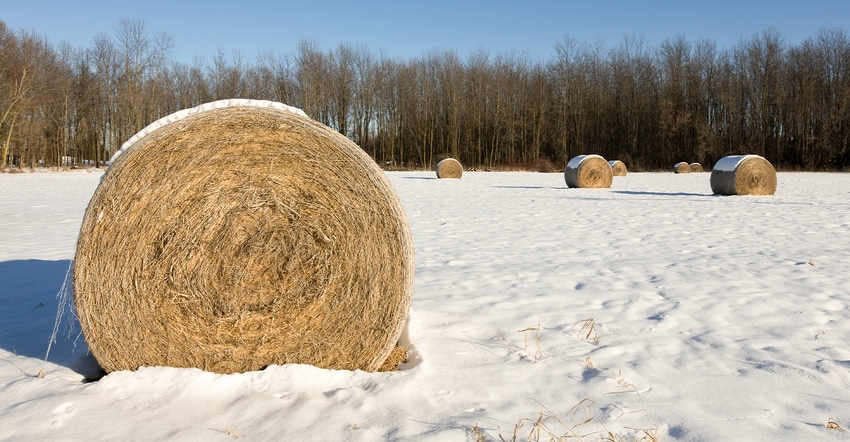January 16, 2020

Driving around the southwest region of Missouri, Eldon Cole, a livestock specialist with University of Missouri Extension, sees many opportunities for livestock producers to improve their winter forage use.
He reminds farmers that about two-thirds of the cost of keeping a cow for a year is the cost of feed, of which winter forage is a major share.
Key considerations
One way to approach improvements is to ask yourself six basic questions as you move through the winter-feeding season:
1. Have you ever had a laboratory analysis of your hay or haylage? It's amazing how many farmers have never spent the $20 to $30 to find what is really in the bale from a nutritional standpoint, Cole says. Key items include moisture, total digestible nutrients (TDN), crude protein, and neutral detergent fiber (NDF). Relative forage quality may help when comparing forages, but RFQ is not viewed as a nutrient.
2. Have you weighed any of your bales? Large hay packages are typically overestimated in weight. This may be worse on haylages as moisture levels will cause an overestimate on dry matter. You do not need to weigh every bale, but Cole advises weighing some out of each different type of hay.
3. Do you have an idea how much waste there is from a bale feeder, or where the unrolled bales are fed? It may surprise some that even under ideal conditions, a 6% to 10% waste is likely. If the bale feeder is not a top-of-the-line, well-managed one, waste levels of 25% to 35% are not unreasonable. Cone-shaped feeders receive the best marks for hay savings based on research. Hay quality, based on lab tests and stage of maturity, also is a major factor in wastage.
4. Are there "problems" in some of the hay and haylage you plan to offer your cattle? Examples are high nitrate levels, ergot alkaloids, and toxic or undesirable weeds such as spotted knapweed and johnsongrass, which you don't want to be spread to some of your fields.
5. Do you have nutritional guidelines for the various classes of cattle you plan to feed this winter? The main considerations would be daily dry matter intake, TDN, crude protein and NDF. Guidelines usually are available from your Extension livestock specialist.
6. Do you sort cows, heifers and weaned calves into nutrient groups, so the ones with the greatest nutritional need receive the best hay? Dry cows, lactating cows, weaned calves, and those with body condition scores of 4 and lower should be fed apart from cows with a BCS in the 5 to 7 range. Don't forget to get the bulls in shape for the next breeding season.
Source: University of Missouri Extension, which is solely responsible for the information provided and is wholly owned by the source. Informa Business Media and all its subsidiaries are not responsible for any of the content contained in this information asset.
You May Also Like




